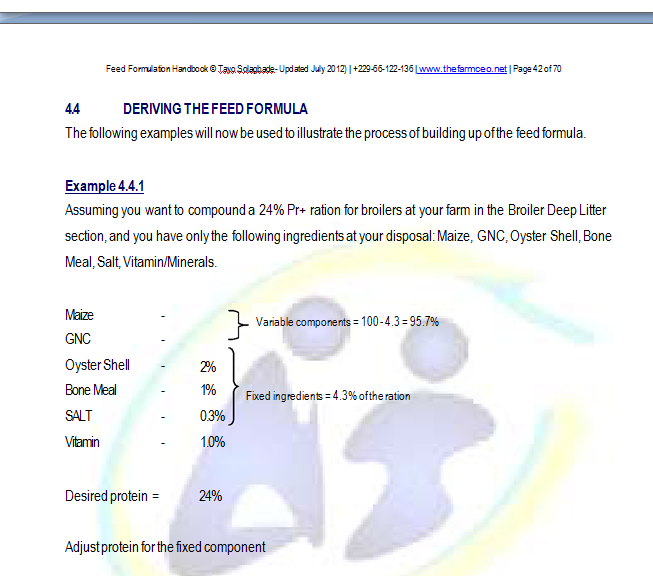Last week, I had to respond to a Ugandan farm CEO client who requested my help formulating 3 rations (30%, 20% and 16% protein content respectively) using the Excel-VB Ration Formulator he’d purchased from me (via Western Union Money Transfer payment).
In addition to some notes/screenshots and a short video demonstration, I referred him to this 4 part screenshot demonstration video (click here) I created for an Algerian PhD student enquirer in 2014.
During the same period I responded to a support request from a Benin City, Edo State – Nigeria based new Farm CEO client’s request for help with use of the Feed Formulation Handbook he’d purchased along with the software as part of what I call the Feed Formulation Bundle.
This second CEO was having difficulty understanding the thinking behind the adjustment calculations illustrated in the handbook
In particular, he was stumped by an example case study (screenshot below) in a section on DERIVING RATION FORMULAS using conventional protein and non-protein contributing feed ingredients.
The calculation method used is an improved version of the Pearson Square technique, which allows for more than one protein contributing ingredient to be used (unlike the original technique).
What follows below are notes I created from a transcript excerpt version of audio explanatory notes I emailed to him
This example illustrates the steps to follow in order to compensate for the dilution effect that occurs when non-protein contributing feed ingredients are added to a feed mixture.
To understand the dilution effect referred to:
Assume we need to formulate a ration to contain 24% protein for the target animal. Now, imagine the main protein and carbohydrate/energy contributors are Maize and Soybean – already milled and mixed.
But we also have to add some other ingredients that do not contribute any protein, for the food to be complete and be ready for baby. These other ingredients help to make the ration balanced for all the key nutrients required for the property development and functioning of the animal.
Examples of these other ingredients include items like limestone, salt, vitamin premixes, bone meal etc. Typically, most of these get classed as fixed factor components in a ration.
They generally don’t contribute any significant amounts of protein, but they will take up volume space in the ration that is meant for the target animal.
By implication, when added they will dilute the percentage of protein in the resultant ration. Which means the total protein content will drop below, as is the case for this example, the target of 24%. That will happen because that will not add any significant protein content to compensate for the volume they will displace in the mixture.
So in order to end up with the final 24 percent protein content in the ration, we must start with protein content from the protein contributing ingredients, that is above 24%. That way, by the time the non-protein contributing ingredients are added, their dilution effect will not go below 24%.
This needs to be done, if the target animal is to get a ration that has a minimum of 24% protein content.
The feed formulation handbook explains, using a diagrammatic method, the procedure for carrying out that adjustment calculation.
In animal nutrition, it is important to establish the nutrient requirements of the target animal for which a ration is to be formulated.
For instance day old layer chicks have a certain requirement for protein, energy, fibre content in their diets. In the same way adult layers also have specific nutrient requirements which are very different from what they chicks have.
So in the handbook you will see that there is a set of pages devoted to that e.g. nutrient requirements of different classes of poultry including broilers, growers, and chicks. And the nutrient requirements for each group generally differ – in terms of their content requirements of energy, protein, fibre etc.
So there is a variation depending on the class of animal, and even the conditions under which the animals are kept.
For instance, with animals kept in cages, you don’t want to give them rations that are too high in energy content.
Why?
Because they could begin to deposit fat causing potential performance problems. And that would happen because they would not have the means to burn it off, since they would be restricted from running around to exercise.
If they are layers and start depositing fat, they could develop fatty deposits in their rear ends, making it difficult for them to expel the eggs – thus affecting their laying performance.
You will need to read up on all of this and make sure you get a sound understanding of it. The handbook gives you a good foundation to get started.
Learn more about my Feed Formulation Bundle (comprising the popular 60 page Practical Livestock Feed Formulation Handbook and the Excel-VB Ration Formulator software) and the 30 page Annotated Pictorial Introduction to Feed Ingredients bonus PDF report.
